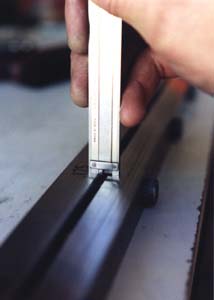| As you approach the target
dimension of your groove, it is a good idea to regularly check its depth
with the depth gauge extension of your dial caliper. If you are making
forms that are six feet long, the tip end of the butt section groove
should be .085 inches deep, and the the deepest end of the butt section
groove should be around .155 inches deep. The tip end of
the tip section groove should be .025 inches deep, and the butt end
end of the tip section groove should be around .095 inches. However,
it is the depth of the tip end of the tip section groove that is the
critical measurement. Making the groove deeper than .025-030 could
limit the rod tapers you are able to make using your forms.
If you successfully cut this shallowest tip station at .025-.030, and
the rest of the tip groove has a slope that increases at approximately
.005 from station to station, you should be in good shape (also try
to get a .085 depth for the tip end of the butt section groove).
The measurement for the butt ends of the tip and butt grooves are not
critical, and will likely deviate due to the mathematical issue that
I had discussed earlier in which .00577 was the actual width increment
one would need to use in order to achieve a true .005 increment in the
slope of the groove's depth. Since I used .005 for the width instead,
the slope of the groove will not be exactly .005 deep from station to
station.
When you approach your target dimension it is
very important to not accidentally file
the grooves too deep, which can be an very easy thing to do when completing
the relatively shallow tip section groove. It is better to err
on the side of a tip station that is cut too shallow than to cut one
that is too deep. |












